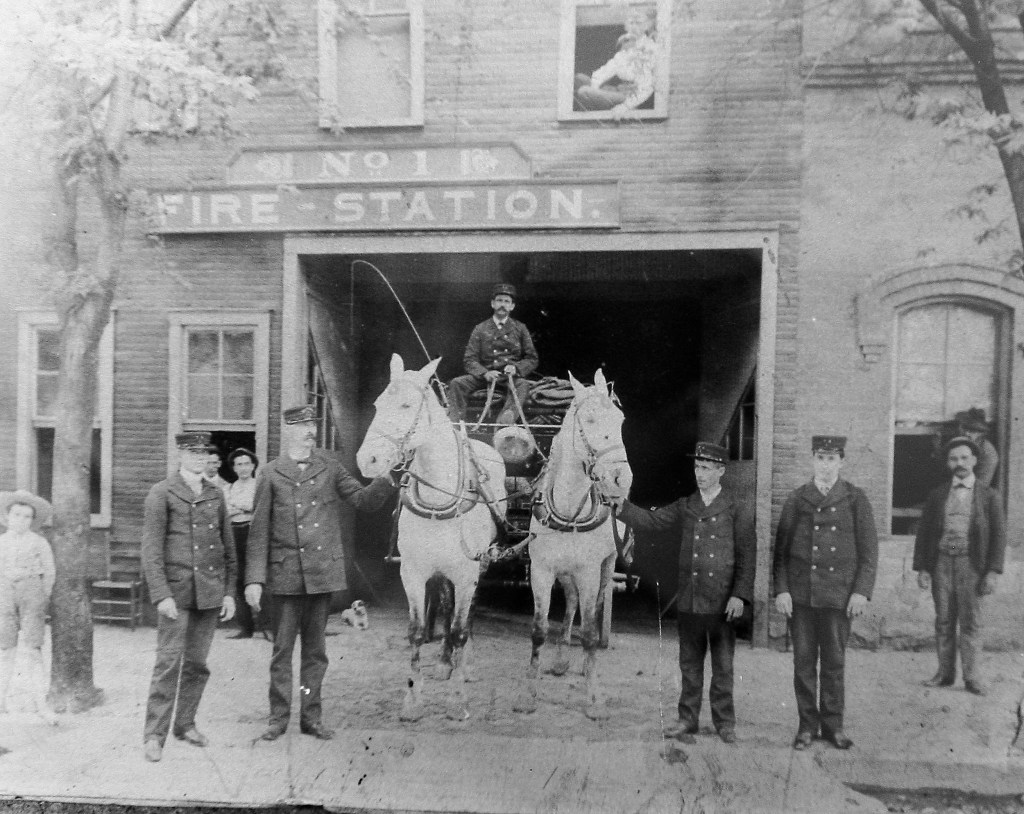Better equipment, training aid firefighters
Published 4:02 pm Friday, September 14, 2012

- (Photo courtesy of the Bowling Green Fire Department)
Lester Lawrence’s specialty when cooking for his fellow firefighters was rice pudding for dessert.
He remembers each of the firefighters taking turns cooking when they were on shift, and some of the offerings were not up to his expectations.
Trending
“Oh boy, I was one of the better ones,” Lawrence said.
Lester Lawrence, 90, sometimes has trouble remembering his days as a member of the Bowling Green Fire Department, but his wife, Jeanetta Lawrence, 83, remembers him telling her about the camaraderie at the fire station and how the firefighters would play practical jokes on one another.
Lester Lawrence joined the fire department after losing his factory job, Jeanetta Lawrence said.
He said he was grateful the security the work at the fire department provided.
“One thing, you knew you wasn’t going to lose your job,” he said.
The schedule that her husband worked was hard on the family, often forcing her to fill the roles of both mother and father for their son, Perry, Jeanetta Lawrence said. Lester worked a schedule where he was on duty for 24 hours and then off duty for 24 hours.
Trending
The schedule changed from on 24 hours and off 48 hours in 1964, which they still work today, according to a history of the BGFD provided by the department. In the early 1900s, firefighters worked a schedule of six days and six nights on duty and one day off.
Lester Lawrence joined the Bowling Green Fire Department in 1952 at the age of 31 and retired 22 years later. At 90, he has been alive for about half of the 180 years since the first engine house was constructed for the volunteer department that preceded the BGFD.
The Kentucky General Assembly granted Bowling Green the authority to raise up to $700 for the purchase of a fire engine in 1820, but there is no record of action being taken until 1831, according to a history of the BGFD, which was published in the periodical Kentucky Professional Firefighter and copyrighted 1977.
The first engine was purchased in 1831 from the American Hydraulic Company for $300, according to the BGFD history. An engine house had been constructed by September 1832.
Fire Chief John Moltenberry talked about his experience with the early volunteer fire department in an interview with a Daily News reporter in 1925. Moltenberry joined the fire department at the age of 21 as a volunteer. He remembered that all the firefighters in his younger years in the department lived at their homes and ran to fires when the alarm was sounded. Sounding the alarm involved ringing the court bell and blowing the whistles at the railroad station at the time.
Firefighting equipment included fire hose and hand reels that had to be transported under the power of the firefighters because there were no horses to pull them, according to the story.
Moltenberry said the volunteer fire department had about 40 men, while the professional department in 1925 had 10 and numbers had not increased since 1904, according to the story.
During the days of the volunteer fire department, firefighters were paid $2 for each fire they attended and there were an average of about 60 fires a year, while the department handled 136 runs in 1924, according to the story.
The paid fire department was established Sept. 1, 1898, according to the BGFD history.
The Kentucky Professional Firefighter story states that one of the main reasons the paid department was established was because of a fire July 3, 1898, that destroyed the Potter Opera House on Main Avenue and College Street and badly damaged the nearby building of Potter’s Bank and Watkins Furniture Store.
The alarm for the fire was sounded shortly after a pre-July 4 celebration of the firefighters, the story states. It also states that: “The condition they are said to have been in did not permit them to respond as soon as they should have.”
The paid department had an advantage over the volunteers in terms of equipment. Its headquarters moved to a new location on State Street, and the firefighters could ride on a hose and chemical wagon pulled by a team of horses instead of pulling their equipment, according to the BGFD history.
The chemical tank contained water. A mixture similar to the soda-acid found in some fire extinguishers was added to the water to create pressure and force the mixture through the hose to fight the fire, according to the Kentucky Professional Firefighter story.
The volunteers, however, still aided the paid firefighters with their pulled hose reels until the early 1900s, when the department was expanded, according to the BGFD history. At about the same time, 17 fire alarm boxes were placed in the business section of Bowling Green, only to be abandoned as telephones became widely available.
A new central fire station costing about $10,000 was completed in 1909, and by 1913, the purchase of a motor-powered hose and chemical wagon was being recommended, according to the BGFD history. Moltenberry, who was chief at the time, is said to have approved of the purchase of a motor-powered wagon because “the horses were always getting sick.”
The motor-powered wagon arrived in 1914 and by 1918, horse-drawn engines had been eliminated, according to the history.
In 1955, the number of fire stations increased from one to three, according to the history. A fourth was opened in 1970.
It was in 1977 that black firefighters first joined the department, along with the first women, according to the Kentucky Professional Firefighter story.
A new headquarters on Seventh Avenue replaced the old headquarters building in 1980. That building still had a hay loft for horses. In 1999, a substation opened on the north side of the city. Two older substations were replaced in 2001. An additional substation was built in the Greenwood area in 2009 and a new administrative building was built near the fire department headquarters, according to the history.
Richard Storey joined the fire department at age 34 in 1982 to get back to Bowling Green after leaving upon graduating from college. Before that he was a ranger with the National Park Service and was working at Cumberland Gap National Park.
Originally, he thought it would be a temporary job until he found something better, but that never happened, he said
“It was luck,” Storey said. “It was a good place to work and mostly good people to work with and for, so I stayed.”
He worked as a fire investigator for many years and also served as fire marshal, which involved doing fire inspections on buildings.
Over time, firefighters who work in fire suppression have started doing more inspections on buildings. Storey said the practice helps make firefighters more familiar with the layouts of the buildings in the area they work and can better prepare them to fight a fire in that building if one occurs.
“You’d be amazed how much you remember going in a building even one time,” he said.
During his tenure on the BGFD, Storey saw stricter building codes go into effect and be enforced. Unfortunately, he said that was often the result of a tragedy. For example, he said the 1977 Beverly Hills Supper Club fire in Southgate, where 165 people died and 70 were injured, made people take building and fire codes more seriously.
“Even though the codes were in effect at that time, they were just ignored,” he said.
The use of fire safety devices in buildings such as fire alarms and sprinkler systems is also more common now, he said. Sprinkler systems are also required in more cases.
“I think buildings are safer now,” he said.
The last fire he investigated was an arson case at the Howard Johnson motel, where Warren County Water Co. is now, in January 1996. Storey worked with the Bureau of Alcohol, Tobacco, Firearms and Explosives in investigating that fire. Four people died in that fire and the men found guilty in the case were sentenced to life in prison, he said.
“I enjoyed working with the people trying to make Bowling Green a safer place to live and work and play, and I like to think I had some success in that,” he said.
He went on to other positions in the fire department and retired in 2006. He was serving as assistant fire chief when he retired.
Retired Fire Chief Gerry Brown started work at the BGFD in 1977 after reading a story about a New York City firefighter. He had recently been laid off from his job with L&N Railroad and thought becoming a firefighter sounded like an interesting career, he said.
One big change since Brown joined the fire department has been the quality of equipment that firefighters use, he said.
Breathing apparatuses were just becoming widely used when he started, and they were resisted by some of the older firefighters.
Big improvement in Brown’s early days came in the form of the materials that protective equipment was made of, which he said were inspired by the space program.
“We had plastic helmets and glorified raincoats … but that changed in the very first few years to much better protective equipment,” he said.
By the time he left the department, each company had a thermal imager to help see through the smoke to better fight a fire, Brown said. “It gave us our vision back,” he said.
Brown served as the assistant chief over training for about five years and said a lot has changed in the department over the years when it comes to training.
Training on how to deal with hazardous materials became a priority after a chlorine leak at Bowling Green Municipal Utilities in 1990.
A story in a February 1991 edition of the Daily News states that the fire department was fined $18,000 by the state for not following proper safety procedures during an August 1990 chlorine leak at BGMU.
“They’re the kind of calls that don’t happen often, but they have a high potential for maybe even disaster but certainly injury or loss of life,” Brown said.
That training helped prepare the department for anthrax scares around the country following the Sept. 11, 2001, terror attacks.
An emphasis on how firefighters can protect themselves while helping others also evolved while Brown was doing training.
In 1998, he became chief and he retired in 2006.
Brown said he’s proud of accomplishments during his time as chief such as improved fire protection north of the river with the building of a new substation and the replacement of two other stations, though he noted that those improvements were also the accomplishments of his predecessor and others in the department.
“That was exciting because you can see progress happening right before you,” he said.







